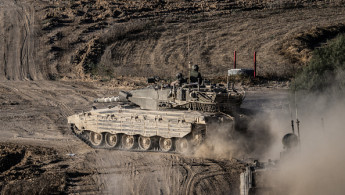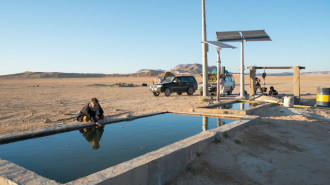After 9 months of war, Palestinian armed groups adopt 'guerrilla warfare' against Israel
After more than nine months of war, Israeli political and military circles claim that they are "close to eliminating" Hamas's military capabilities in the Gaza Strip.
On 1 July, Israeli Prime Minister Benjamin Netanyahu claimed that the Israeli army is advancing to the "end of the phase of eliminating" the Hamas movement "army" in the besieged coastal enclave.
Speaking to a group of Israeli and international military officials at the National Security College, Netanyahu added, "I returned yesterday from a tour of the Gaza Division, and I saw there very great achievements in the fighting taking place in Rafah. We are advancing to the end of the phase of eliminating the Hamas army."
"We will continue to strike the remnants of Hamas," he said, claiming that the war's goals of returning the kidnapped, eliminating Hamas's military and governmental capabilities, ensuring that Gaza does not pose a threat, and returning Israelis to the south and north safely will be achieved.
Israeli media also outlets quoted political and military officials as saying that the army has begun moving to the third stage this month, which is adopting the strategy of "attacking Hamas sites by land and air according to the intelligence information they obtain."
The Israelis claim they have succeeded in destroying "more than 50 percent" of Hamas's military capabilities, in addition to killing "tens of thousands" of Palestinian fighters.
But the Palestinian armed resistance in Gaza, which includes Hamas' Al-Qassem Brigades and other armed factions, still persists on the ground.
Military experts from Gaza, who preferred not to reveal their names for security reasons, noted to The New Arab that while no analyst denies that Israel has been able to bomb dozens and perhaps hundreds of military sites containing tens of thousands of rockets and ammunition used by armed groups and inflict massive damage to civilians in Gaza, the Israelis have yet to eliminate the determination and capabilities of Palestinian armed groups across all political spectrums.
"Israel is fully aware that it will not be able to eliminate the idea of resistance. Even if it kills every last Palestinian fighter, Palestinians will volunteer themselves again to respond to Israel's crimes," one of the experts said.
In major countries, another expert noted, if the army lost a third of its military capabilities, "it would have declared surrender, not out of cowardice, but to preserve its military capabilities for possible future confrontations. But, the Palestinian resistance is not facing a similar battle. They're sending a message to Israel that it will never be able to eliminate the very idea of resistance."
50 percent of tunnels are still effective
According to the Israeli army, about "50 percent" of the tunnels in the Gaza Strip are "still effective," which makes Palestinian fighters capable of "launching an attack near the border between Gaza and Israel and perhaps being able to cross it."
The army's estimates, reported heavily by Israeli media, noted, "The condition of the tunnels in the camps in the central Gaza Strip allows Hamas to carry out attacks above and below ground."
To make matters worse for the Israeli army, Israeli Channel 13 reported that Hamas has allegedly restored several tunnels in Khan Younis and a concrete factory that produces materials needed to build tunnels.
According to the Israeli claims, Hamas tunnels are still in good condition in the central camps, most of Rafah city, and the Shujaiya neighbourhood.
Furthermore, Abu Obeida, spokesman for Al-Qassam Brigades, Hamas's military wing, said in a televised speech on Sunday that the resistance has managed to recruit thousands of more fighters and still has the initiative and surprise in the field.
Abu Obeida claimed that at least 24 brigades are still operating and inflicting heavy losses on the Israeli occupation.
'Guerrilla Warfare'
Guerrilla warfare is considered one of the most important military tactics mastered by the Palestinian resistance and becoming more present in this current war. This form of warfare relies on hit-and-run tactics, setting up ambushes and using snipers, and basically avoiding face-to-face confrontation with Israeli soldiers as much as possible, while increases the number of casualties.
Military sources close to the resistance said that Hamas has relied on its tunnels, its fighters, and its weapons stockpile to compliment the strengths of guerrilla warfare.
The sources further explained that Hamas allowed other Palestinian factions to use its ammunition and tunnels for offensive purposes against Israeli soldiers. These attacks carried out by Hamas are usually carried out by a cell of only two to five people.
Military sources further noted that the Palestinian fighters are attacking more aggressively, firing more anti-tank weapons at Israeli soldiers who often take cover in destroyed homes and at Israeli army vehicles at a daily rate.
And lately, Palestinian fighters have resorted to planting explosive devices in areas where it was likely that the Israeli tanks would enter, especially in sites that were previously attacked by Israeli forces.
Military sources in Gaza said that Palestinian fighters were able to reclaim numerous remnants of the occupation army's ammunition, such as mines and unexploded missiles, recycling them to use against Israeli soldiers.
Although Hamas was able to fire more than 10,000 rockets at once on Israeli towns next to the Gaza Strip on 7 October, the number of missiles fired from the coastal enclave is notably less since then.
According to TNA's count, no rockets were launched from the Gaza Strip during February, March and April.
However, the Palestinian Islamic Jihad's Al-Quds Brigades was able to launch dozens of rockets this past month.





 Follow the Middle East's top stories in English at The New Arab on Google News
Follow the Middle East's top stories in English at The New Arab on Google News


